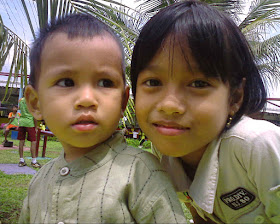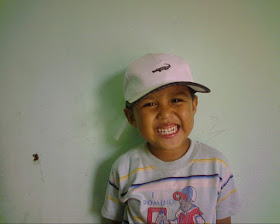The division of the group Make Match And there are two groups of problems and holding group holding group answers. Make And Match can be made for all subjects and at all levels of education starting from elementary through high school.
Initial preparation to be done in this learning model to inform teachers on what to study at the next meeting. Thus students have a capital initial capital in learning. With initial capital of the subject matter of discussions in the learning process Make And Match can take place properly.
In detail the steps in learning Make And Match is as follows.
Step by step:
1. Teachers prepare some cards that contain several concepts or topics are appropriate for review sessions, one about the card section and other parts of the answer cards. These cards should be designed so that the card draw students. We can use the cartoons, or pictures from magazines, the Internet or other sources for the material. Teachers can also prepare the writings in which the card is designed in such a way that is easy to understand and be understood by students. Specify the language used should be tailored to the level of education. By default use Indonesian well right.
If the matter has to do with images, charts, schematics, made so clear.
The material can also be made in the form of questions or problems, related to SK or KD demands that have been determined. Problem arranged so gradually from C1 to C6 or from P1 to P4.
2. Each student received a card
Before cards are dealt you have to classify students into two groups who hold the card or the material issues and holds the answer card. Each of these groups ceased to be grouped according to ability and level of difficulty encountered problems. Students who have a high capacity cards will be distributed to the cognitive level higher, and vice versa.
The division of the card must be made randomly but regularly in accordance with their respective levels.
3. Each of the students think of an answer / question of cards held
At the time cards are dealt, give them the time between 10 minutes to 15 minutes to think about issues and answer each of the cards they hold. They can discuss with fellow group members cardholders, looking at books, internet, maps, globes, dictionaries, notes or other learning resources used at that time. Provide opportunities for all to think about and answer to every problem.
4. Each student find a partner who has a matching card with the card (about the answers)
After the problem solved, the students find a partner to each other. To avoid confusion in turn can be searched by providing opportunities to the students individually to read the question or issue or matter, after it was able to find their partner.
Search time is given when for example there are problems then the 10 points were given 10 s / d 1. Students who found the couple in the first 1 minute scored 10, on the first 2 minutes in gave the score 9, the first 3 minutes was given a score 8 and so on. Until the last 10 minutes. Or each pair can also find a pair that were scored 1.
5. Each student is able to match the cards before the deadline given points
Points can be awarded in accordance with the method above, by providing a multilevel score or the score 1 and 0, students can find a spouse in accordance with the time given in the given score 1 and is not able to find answers were scored 0.
6. After one round of cards to be disturbed again learners each get a different card than before. The next card in the whipped and given randomly according to the level of individual ability. Re given the chance in the group, if the members were more than 1 person. Then go back to step 4 and 5.
7. And so on, do it repeatedly until the learning is complete. Anyone who champions give their appreciation, so the next time better. Give the motivation for that has not been successful.
8. Conclusion / cover. When finished make a conclusion together.
Okay I'll see you again greetings from us in Banyuasin. Go on education in Indonesia.
Sumbangkan terjemahan yang lebih baik
Terima kasih telah menyumbangkan saran terjemahan Anda ke Google Terjemahan.
Menyumbangkan terjemahan yang lebih baik:
Make Learning Model And Match (Looking for Couple)
This model is a model developed by Lorna Curran, 1994. Like other models, this model is a model of group learning (Learning Community). This model can generate with semangan student learners to engage actively in the learning process.
The division of the group Make Match And there are two groups of problems and holding group holding group answers. Make And Match can be made for all subjects and at all levels of education starting from elementary through high school.
Initial preparation to be done in this learning model to inform teachers on what to study at the next meeting. Thus students have a capital initial capital in learning. With initial capital of the subject matter of discussions in the learning process Make And Match can take place properly.
In detail the steps in learning Make And Match is as follows.
Step by step:
1. Teachers prepare some cards that contain several concepts or topics are appropriate for review sessions, one about the card section and other parts of the answer cards. These cards should be designed so that the card draw students. We can use the cartoons, or pictures from magazines, the Internet or other sources for the material. Teachers can also prepare the writings in which the card is designed in such a way that is easy to understand and be understood by students. Specify the language used should be tailored to the level of education. By default use Indonesian well right.
If the matter has to do with images, charts, schematics, made so clear.
The material can also be made in the form of questions or problems, related to SK or KD demands that have been determined. Problem arranged so gradually from C1 to C6 or from P1 to P4.
2. Each student received a card
Before cards are dealt you have to classify students into two groups who hold the card or the material issues and holds the answer card. Each of these groups ceased to be grouped according to ability and level of difficulty encountered problems. Students who have a high capacity cards will be distributed to the cognitive level higher, and vice versa.
The division of the card must be made randomly but regularly in accordance with their respective levels.
3. Each of the students think of an answer / question of cards held
At the time cards are dealt, give them the time between 10 minutes to 15 minutes to think about issues and answer each of the cards they hold. They can discuss with fellow group members cardholders, looking at books, internet, maps, globes, dictionaries, notes or other learning resources used at that time. Provide opportunities for all to think about and answer to every problem.
4. Each student find a partner who has a matching card with the card (about the answers)
After the problem solved, the students find a partner to each other. To avoid confusion in turn can be searched by providing opportunities to the students individually to read the question or issue or matter, after it was able to find their partner.
Search time is given when for example there are problems then the 10 points were given 10 s / d 1. Students who found the couple in the first 1 minute scored 10, on the first 2 minutes in gave the score 9, the first 3 minutes was given a score 8 and so on. Until the last 10 minutes. Or each pair can also find a pair that were scored 1.
5. Each student is able to match the cards before the deadline given points
Points can be awarded in accordance with the method above, by providing a multilevel score or the score 1 and 0, students can find a spouse in accordance with the time given in the given score 1 and is not able to find answers were scored 0.
6. After one round of cards to be disturbed again learners each get a different card than before. The next card in the whipped and given randomly according to the level of individual ability. Re given the chance in the group, if the members were more than 1 person. Then go back to step 4 and 5.
7. And so on, do it repeatedly until the learning is complete. Anyone who champions give their appreciation, so the next time better. Give the motivation for that has not been successful.
8. Conclusion / cover. When finished make a conclusion together.
Okay I'll see you again greetings from us in Banyuasin. Go on education in Indonesia.
























Posting Komentar